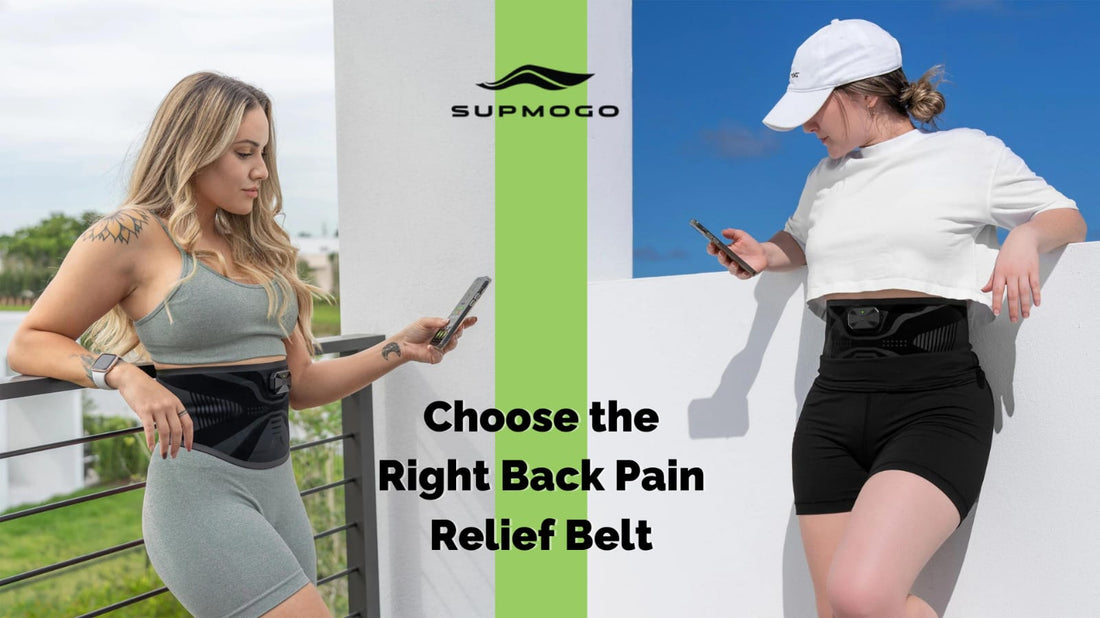A tingling back pain that doesn't even let you sleep peacefully straight on your back. Moreover, if this Makes you dependent on support for even getting to the restroom, it needs a solution.
Many of you might go for home treatments or hop on painkillers and feel good. But at the same time, scraping off back pain is not that easy. Here is where back support belts come into the limelight.
Back support belts are constructed in a design to accommodate you to improve your healing process and build strength without losing a bucket of sweat. It will help you not to overstep the mark and restrict any movement that might cause you more harm.
But how will you know which back belt best partners with you in combating pain? Let's dive into this guide and learn about different types of back pain to choose a back brace accordingly.
Here is what you’ll learn in this article:
▪️ Types of Back Pain
- Acute Back Pain
- Chronic Back Pain
- Lower Back Pain
- Upper Back Pain
- Radicular Pain
- Referred Pain
- Myofascial Pain
- Psychogenic Pain
- Postural Pain
▪️ How Can I Choose the Best Back Belt for Back Pain Relief?
- Materials
- Comfortability
- Adjustment
- Stability
- Size
- Technology
Types of Back Pain
To find the right type of back pain belt for you, you should first know the type of back pain you are experiencing. Here are some common types of back pain:
1. Acute Back Pain
This type of back pain occurs out of nowhere and lasts for a short time (<6 weeks). Acute back pain mainly happens due to muscle lesions, injury, or sprain.
2. Chronic Back Pain
Chronic back pain lasts a more extended period (> three months) and can be more severe than other types of back pain. Chronic back pain often results from imbalanced posture, injury, or medical conditions.
3. Lower Back Pain
Lower back pain is associated with the lumbar area of the back. This type of pain is common among old and young for several reasons, such as disc disease, injury, posture issues, heavy Lifting, prolonged exercises, etc.
4. Upper Back Pain
Upper back pain mostly happens due to poor posture, less activity, or herniated disc. However, this type of back pain is less common among people than lumbar pain.
5. Radicular Pain
Radicular pain occurs when a nerve is pinched or irritated in the spine. This extreme pain may lead to numbness and swelling due to poor blood circulation.
6. Referred Pain
This type of pain occurs due to problems in other body areas. For example, during UTI, people face back pain due to the connection of the back with the pelvic area.
7. Myofascial Pain
Sometimes muscles develop trigger points on the back side that can cause pain occasionally. These trigger points can also spread to other points of the body.
8. Psychogenic Pain
Research proves that Stress and anxiety can cause back pain too. [1] Psychological distress can cause changes in breathing, inhibiting blood flow and developing muscle tension.
9. Postural Pain
Misalignment of the spine bone can cause back pain that is resolved once posture corrections occur. The pain can be dull or sharp, but constant pressure occurs, which might lead to numbing specific areas of the back.
Staying in one position, e.g., sitting, sleeping on one side, or standing for too long, can cause this type of pain.
How Can I Choose the Best Belt for Back Pain Relief?
The following points can help you to get the best back support belt for your customized needs:
1. Materials
Back support belts with nylon and neoprene can be best for back pain. Neoprene is stretchable and gives good compression that will add up good support and warmth at the same time.
2. Comfortability
A back pain relief brace should be comfortable enough and not irritate you after wearing it. Good quality belts contain soft lining, lumbar pads, or breathable fabric to ensure comfort.
3. Adjustment
You must look for a belt with adjustable straps, hooks, or a pulley system to get a good grip. The easy-to-adjust belt is comfy and provides good support.
4. Stability
Rigid or semi-rigid back braces works best for back pain relief. A stiff and firm structure is necessary to give good pressure to the affected area. At the same time, little flexibility helps in doing minor effort movements.
5. Size
Select back pain according to your waist size, which is not too tight or loose. A pain relief back belt should be comfortable enough and should not exert too much back pressure that will reverse the purpose of a back belt.
6. Technology
Back support belts supposedly for back pain are incorporated with many updated, silver bullet technologies. The most popular ones of the time are:
The dorsal root ganglion is a nerve cluster present in the spinal cord. This stimulating therapy transitions electric impulses to hose nerves and releases the pain.
Infrared laser therapy involves light technology that seeps into layers of tissues to treat back pain. Infrared therapy helps to decrease 50% of back pain within six weeks for most cases. [2]
Electric heating is the production of heat through electric impulses. This technology increases blood flow in the affected area, steadily reducing pain.
Water activation technology is an advanced and high-end science. This technology is available in belts such as Supmogo RecoveryFlex System that activates a gel to provide a cooling or warmth effect.
The effect aids in the contraction of your abdominal muscles and strengthens core muscles by growing resilient fibers.
Inflatable panels are added to build support, especially in the medical back brace. These panels can release or fill up gas according to the fit and provide a better endorsement.
Wrap Up
Fighting back pain needs stronger core muscles and enhanced blood flow. Although back braces are perfect for bringing in and flick through back pain, the disadvantages of wearing a back brace also need to be considered.
Yet, Supmogo RecoveryFlex System is one of those wearable technologies that can be trusted without any caution. The flexible proprietary conductive fabric is hands down best to encourage rehabilitation and avoid any side effects.
Endnotes
- Abdallah, C. G., & Geha, P. (2017). Chronic pain and chronic stress: two sides of the same coin?. Chronic Stress, 1, 2470547017704763.
- Gale, G. D., Rothbart, P. J., & Li, Y. (2006). Infrared therapy for chronic low back pain: a randomized, controlled trial. Pain Research and Management, 11(3), 193-196.

